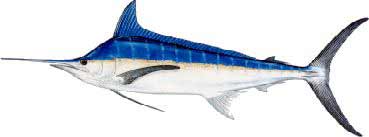Blue Marlin  Makaira nigricans
Makaira nigricansOther common names: Blue Marlin Current IGFA all-tackle record: 1,402 pounds, 2 ounces -- Vitoria, Brazil -- February 29, 1992 Size, Migration and breeding: Males rarely attain a weight above 300 pounds. Very large females are capable of producing over 100 million eggs. Expected temperature range is 70° F to 86° F (21° C to 30° C) Range and Description: This pelagic and migratory species occurs in tropical and warm-temperate oceanic waters. In the Atlantic Ocean it is found from 45° N to 35° S, and in the Pacific Ocean from 48° N to 48° S. It is less abundant in the eastern portions of both oceans. In the Indian Ocean it occurs around Ceylon, Mauritius, and off the east coast of Africa. In the northern Gulf of Mexico its movements seem to be associated with the Loop Current, an extension of the Caribbean Current. Seasonal concentrations occur in the southwest Atlantic (5°-30°S) from January to April; in the northwest Atlantic (10°-35°N) from June to October; in the western and central North Pacific (2°-24°N) from May to October; in the equatorial Pacific (10°N-10°S) in April and November; and in the Indian Ocean (0°-13°S) from April to October. Japanese longliners report that the blue marlin is the largest of the istiophorid fishes. It apparently grows larger in the Pacific. All giant marlins are females, and male blue marlin rarely exceed 300 pounds. The pectoral fins of blue marlin are never rigid, even after death, and can be folded completely flat against the sides. The dorsal fin is high and pointed anteriorly (rather than rounded), and its greatest height is less than the greatest body depth. The anal fin is relatively large, and it too is pointed. Juveniles may not share all the characteristics listed above, but the peculiar lateral line system is usually visible in small specimens. In adults it is rarely visible unless the scales or skin are removed. The lateral line of a Pacific blue marlin is a series of large loops, like a chain, along the flanks. The lateral line of an Atlantic blue marlin is a reticulated network that is more complex than the simple loops of the Pacific specimens. The vent is just in front of the anal fin, as it is in all billfish except the spearfish. The back is cobalt blue, and tile flanks and belly are silvery white. There may be light-blue or lavender vertical stripes on the sides, but these are never as obvious as those of the striped marlin. There are no spots on the fins. They are known to feed on squid and pelagic fishes, including blackfin tuna and frigate mackerel. A powerful, aggressive fighter, they run hard and long, they sound deep and leap high into the air in a seemingly inexhaustible display of strength. Fishing methods include trolling large, whole baits such as bonito, dolphin, mullet, mackerel, bonefish, ballyhoo, flying fish and squid as well as various types of artificial lures and sometimes strip baits. |
||